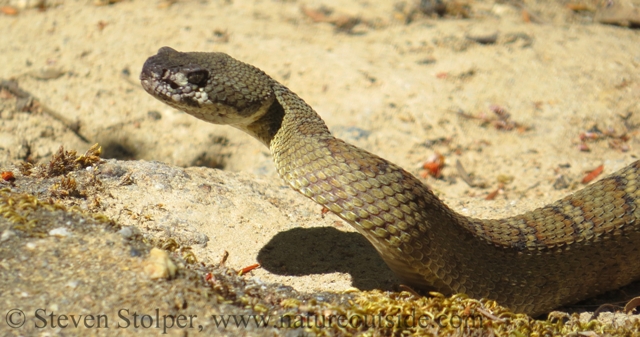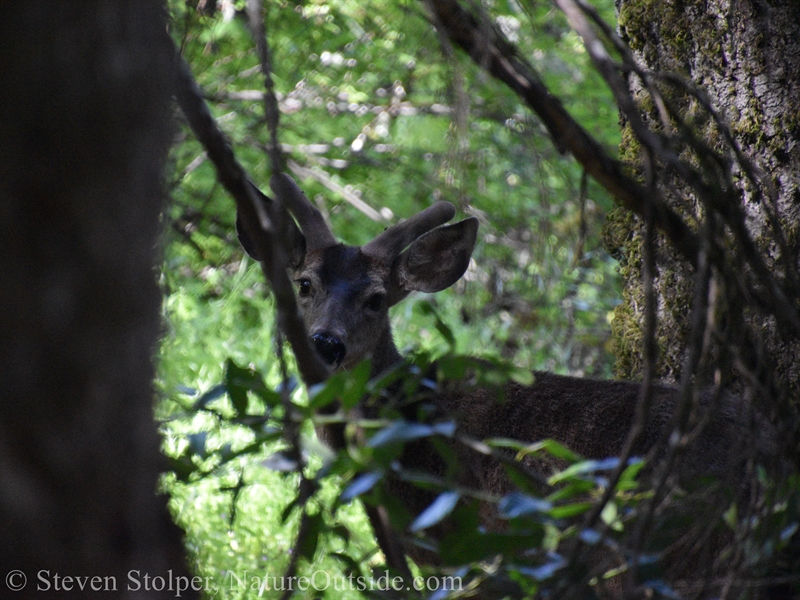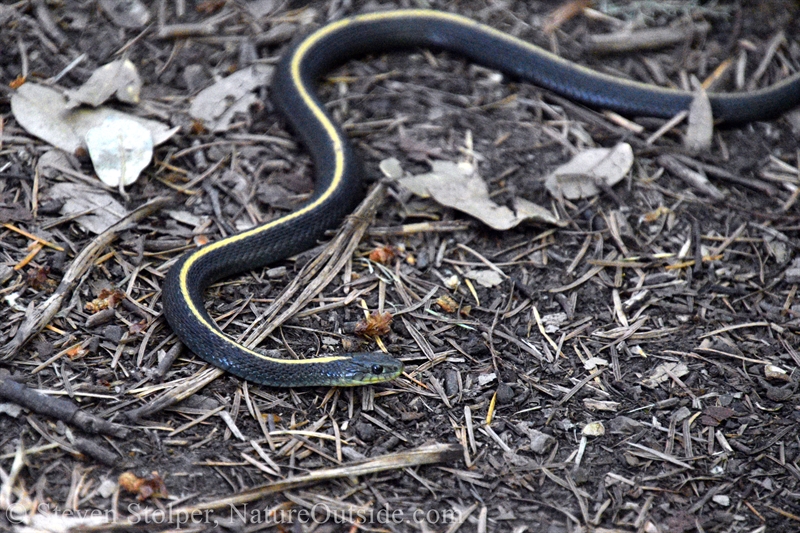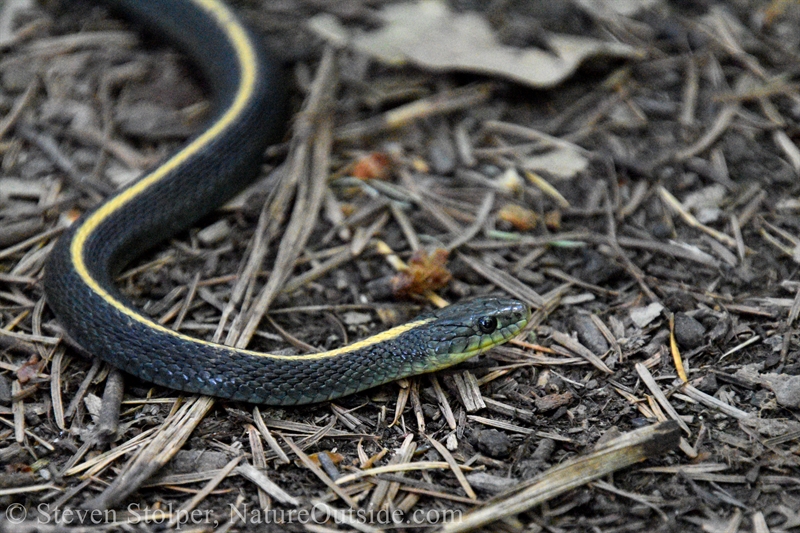
I want to share a recent snake encounter.
The Crown of the Santa Cruz Mountains
My friends and I gaze outward from our lofty perch. We’re standing on the crown of the Santa Cruz Mountains. From our hilltop, 2,500 feet above sea level, we look down upon the San Francisco Bay area. Turning 180 degrees, our view stretches far to sea with the surface of the Pacific Ocean obscured by low clouds.
It’s mid-afternoon and the sky above is piercing blue. My hand instinctively checks the chin-strap of my hat as wind gusts try to seize it for their amusement.
We’re halfway through our seven-mile hike. And it’s time to move on. But I’m reluctant to leave this majestic view. I’m reminded of Walt Whitman, “Keep your face always toward the sunshine – and the shadows will fall behind you.”
As we descend to the trail below, my attention is caught by a small group of people farther down the trail. We’re near a trailhead parking lot. So it’s common to see people on the trail. But these people aren’t hiking, running, or biking. They’re just standing. And from their eyelines, I can tell they’re looking intently at something on the trail about 20 feet to their front. From experience, I lay even odds between “snake” and “dead animal.”
A Snake in the Grass
We arrive to find a diminutive woman in her early 30’s. She’s quite agitated, and I can see why. At the side of the trail is a large, adult Northern Pacific Rattlesnake (Crotalus oreganus oreganus). It’s between 4 to 4.5 feet (1.4 meters) long. The heavy-bodied, muscular adult is coiled defensively and prepared to strike.
The Northern Pacific Rattlesnake is native to this area of California. The “Crotalus” part of its scientific name comes from a Greek word meaning “little bell.” This, of course, refers to its famous rattle.
These snakes prefer drier habitats, like the grassland ridge we’re standing on. Rattlesnakes are “pit vipers” which means they have two pits that sense infrared radiation (heat) when hunting warm-blooded prey. There is one pit on each side of the front of its head, above the mouth. Rattlesnakes have long, hollow fangs connected to venom glands. The fangs inject a toxic venom which quickly immobilizes its prey.
In this area, I suspect the snake dines on lizards, mice, ground squirrels, other snakes, and small birds.
Rattlesnakes are ambush predators. They strike at passing prey and follow the trail of the envenomated animal. They find the immobilized prey and swallow it whole.
And it’s their venom that concerns the young woman.
A Lucky Kick
The woman hastily relates her story. She indicates a tall man approximately 15 feet beyond the snake, farther down the trail. He’s carrying a sleeping infant in a “carrier” backpack.
The woman and her husband were hiking down the trail. The husband was not paying attention to where he was going. The snake had crawled out of the tall grass and was sunning itself on the trail.
Here is where it gets interesting. The husband accidentally *kicks* the snake as he’s walking. At this point I’m alarmed. As I mention in my article on rattlesnake safety for hikers, touching a rattlesnake is the surest way to be bitten. But in this case, the snake only rattled and coiled itself defensively.
I can understand why she’s so frazzled. When adult snakes rattle, it’s shockingly loud. I know this first hand from nearly having one fall on me during a combat dance.
The snake is alert and coiled at the edge of the trail. It’s watching the small crowd that has gathered. This part of the trail is a fire road. And it’s relatively wide.
The woman is worried that she’s cut off from her husband. I calm her by identifying the snake and explaining that, if we leave enough space, we can pass it safely. A mountain biker who stopped to gawk at the snake puts my advice into practice. He slowly walks his bike along the opposite side of the trail. This gives the woman courage. She carefully tightrope-walks the far side of the trail to rejoin her husband.
Seeing the added distance between itself and the people, the snake seizes its opportunity. It turns and slinks off the trail. Such a large snake does not flee in panic, it makes a dignified retreat into the tall grass.
The Infant
I am delighted the snake did not bite the woman’s husband. Even a dry bite would have precipitated a mad dash to the hospital. And the venom from such a large adult can have long-term effects.
I gaze at the infant, quietly dozing in the carrier. I’m glad he was spared today’s drama. I myself have been saved by a rattlesnake’s discretion. And I give thanks we share our continent with a venomous snake that has such a calm demeaner.
This will be a story his parents tell him when he is older.
Epilogue
A few days later, I went on a solo hike to do some animal tracking. I liken it to visiting my non-human neighbors.
I find a young adult deer, possibly growing his first set of antlers. It’s a Columbian Black-tailed Deer (Odocoileus hemionus columbianus). To my delight, I’m able to stalk him for nearly 15 minutes before he detects me.

As I continue my hike, I encounter this adorable fellow.

Santa Cruz Garter Snake (Thamnophis atratus atratus)

It’s time for my close-up!
It’s a Santa Cruz Garter Snake (Thamnophis atratus atratus). Unlike our rattler friend, this snake does not have venom that is dangerous to humans. Garter snakes do have toxins in their saliva that can produce an unpleasant reaction in humans. But they are not considered dangerous. I’ve written before about these amazing creatures.
This snake is only about 20 inches (50 cm) and blends in perfectly with its surroundings. But it creates the opposite problem from the rattlesnake. Humans, specifically mountain bikers, are a danger to the animal.
I make a large demonstration in front of the snake. I stamp my feet, approach slightly closer, and then retreat. Once I give the snake distance, it “escapes” off the trail and into the nearby leaf litter.
By protecting the snake from harm, I feel I’ve repaid a small debt.
Related articles on NatureOutside
For fun facts and useful tips, join the free Bushcraft Newsletter.



Leave a Comment